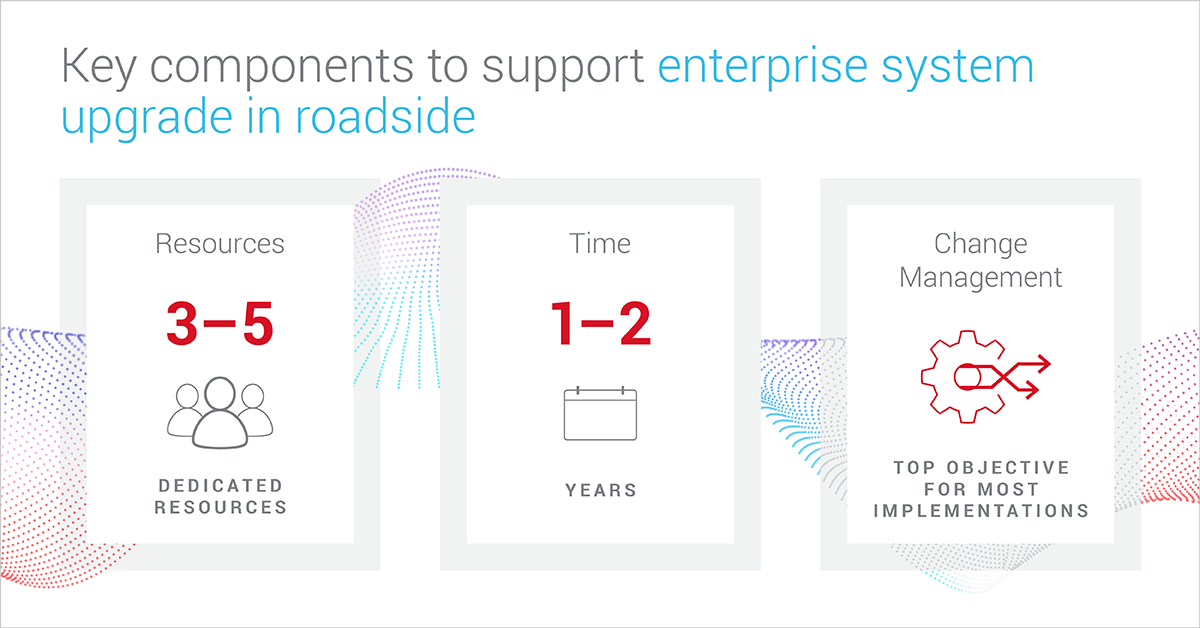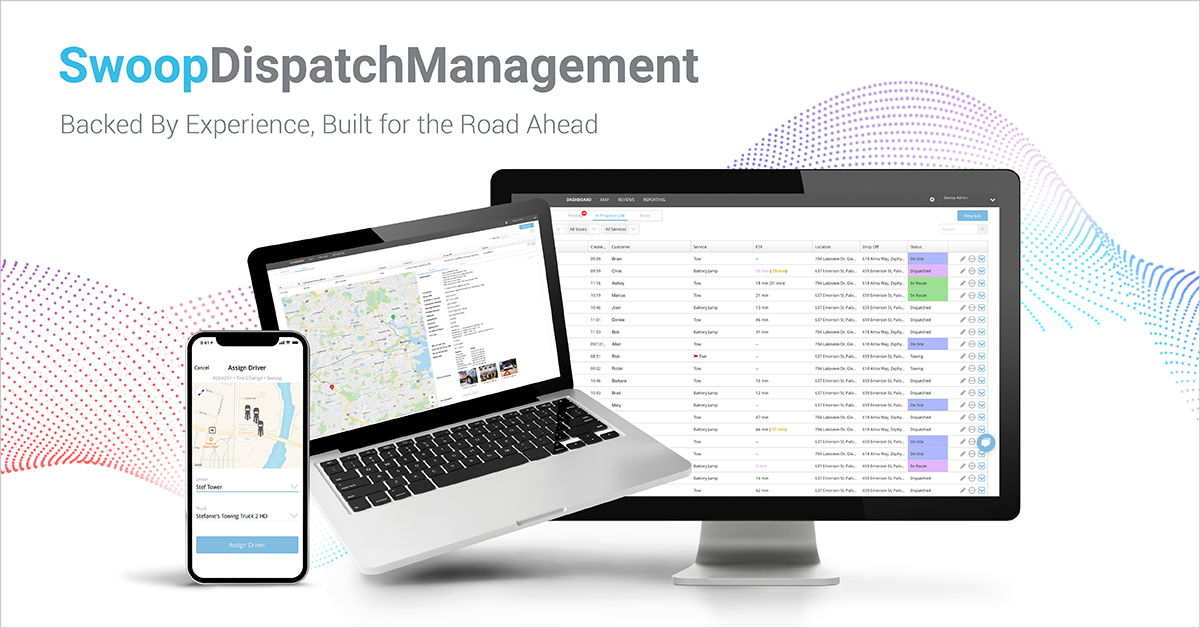Agero Insights

Designing and Supporting Enterprise Upgrades for roadside assistance
July 2, 2021 | 4 min read
For a motor club or roadside assistance company, dispatch and case management software is a truly critical enterprise-wide system, governing all operations, across all stakeholders. As business needs and both client and customer expectations evolve, it can be challenging to deliver today’s experiences on yesterday’s technology. This is forcing the exploration and implementation of new platforms across the globe. These types of enterprise level system changes are hard and disruptive, but they create an opportunity to align and future proof the business.
At Agero, we have a unique vantage point. Our platform team has built Swoop Dispatch Management and over the past few years, we have migrated the Agero business to this platform. This allowed us to further digitize, automate and future-proof our business. Sitting on both sides of this complex integration has shaped both our product and our implementation strategy. We have found that there are three key components to a successful dispatch management integration– the platform, organizational alignment and an experienced industry partner.
The Platform
After 50 years in roadside, the one thing we know for sure is that things will change – vehicles, technologies, communication channels, clients, providers, and partners. With Swoop Dispatch Management, we needed to ensure that features, functions, fields and capabilities could be easily added, changed, and toggled by program, client and even region. We also recognized the complex ecosystem of partners and capabilities needed to support assistance programs. To enable this, we needed a full suite of APIs to ensure that we can readily and easily connect and communicate. In addition, these APIs can facilitate new capabilities like client mobile apps, new channels like voice activation and robust analysis through data aggregation.

However, we also recognize that the only way to meet the changing needs of our business is to continuously and thoughtfully evolve and improve. The core technology architecture is designed for scalability, but we are also continuously looking at system performance and infrastructure to find opportunities to learn, iterate and upgrade. We have a robust product roadmap that is regularly adjusted based on technology trends, industry trends and stakeholder feedback.
This combination of features, functions and architecture has enabled us to shift the Agero business onto the Swoop platform for a digital and transparent experience for agents, clients, customers and providers.
Organizational Commitment and Alignment
Moving from platform selection to integration is complicated and requires organization commitment and alignment. An integration of this scale is likely to touch nearly every department in an assistance company. With a complete solution like Swoop Dispatch Management, the integration can be straightforward but still requires time and a thoughtful process to ensure that all systems and clients are migrated smoothly. The key components that the organization must prepare for and commit to are necessary resources, time commitment and change management.
Resources
To support a change of this magnitude, it is critical to resource appropriately. At Agero, we dedicated a core team of 4 to the project. This is consistent with the typical resources needed for other enterprise-level implementations which found that 90% required at least 3 dedicated resources but nearly half required 5 or more.
Time
It is important to set expectations for the team for an enterprise level integration. The time to implementation can vary based on the size and scope of the organization and can be significantly shorter for smaller operations. However, implementation and go-live for other enterprise level software implementations typically take 1-2 years and the timeline for return on investment is often up to 3 years.
To help manage this lengthy process, there are a few key steps. First, we highly recommend a pilot or pre-pilot. This allows a small subset of the team and a small subset of clients and customers to better understand the software and how it will impact their experience. It is also critical in shaping the overall implementation plan. It is important to break the project down into key milestones and provide clear visibility to the team throughout the process.
Change Management
Lastly, a core component to a successful integration of any enterprise level software is to expect and embrace change. Let’s face it, change is hard, however, it can certainly be worth it. In a recent survey on enterprise integrations, 95% of respondents noted that some or all of their business processes were improved as part of the implementation. This is not surprising given the scope of functions that are impacted as well as the goals for most implementations. In fact, improving business performance, positioning the company for growth and reducing working capital are the top three stated goals. At Agero, the migration of Swoop touched just about every department and team and helped optimize processes across the board. Our team and our leadership embraced this change and gave the core team the scope and freedom they needed

Partner for Success
Roadside is a complicated business and requirements are continuously evolving to meet new technologies, customer expectations and enable powerful dealer, client and provider experiences. At Agero, we know first-hand. We service millions of events every year and analyze and action data to support and inform continuous improvement. This core understanding of running a motor club and everything that entails is critical in the development and integration of a dispatch software solution. Swoop Dispatch Management creates a unique opportunity for roadside assistance companies to leverage this success rather than the high risk, high-cost path of internal platform development.

In addition, there are exciting opportunities for assistance businesses around the world to partner, share best practices and provide consistent seamless experiences to clients in every region. We have found the exchange and insights from our international clients truly insightful and powerful factors in both the development of our platform but also the future of our roadside business. Our partners from every region have played a critical role in shaping our product development roadmap and we look forward to continuing and expanding this collaboration.
We know that delivering exceptional roadside is long and winding so having an experienced partner riding shotgun is key to success. Enjoy the ride.
Meet the Author: Anissa Chen - Senior Product Manager
 Anissa Chen is a Senior Product Manager leading the International Squad focused on SaaS product expansion. She has over 8 years of experience in product management, corporate innovation, and launching partnerships around the world and prior to Agero was a product leader at Mastercard in their internal labs organization. Anissa joined Agero in 2020 because she’s fascinated with cities and mobility and has worked at Nissan in their Future of Mobility strategy team.
Anissa studied economics and public policy at UCLA and graduated from Kellogg School of Management with a double masters in business administration and design innovation. Anissa is a San Francisco native and in her spare time enjoys hiking, biking, snowboarding, and cooking.
Anissa Chen is a Senior Product Manager leading the International Squad focused on SaaS product expansion. She has over 8 years of experience in product management, corporate innovation, and launching partnerships around the world and prior to Agero was a product leader at Mastercard in their internal labs organization. Anissa joined Agero in 2020 because she’s fascinated with cities and mobility and has worked at Nissan in their Future of Mobility strategy team.
Anissa studied economics and public policy at UCLA and graduated from Kellogg School of Management with a double masters in business administration and design innovation. Anissa is a San Francisco native and in her spare time enjoys hiking, biking, snowboarding, and cooking.Recent Posts
Auto Industry Leader Tom Feeney Joins Agero’s Board of Advisors
Former Safelite president and CEO to guide Agero’s strategy across technology innovation and...Agero’s Earns Sixth Straight Best Places to Work Award
Annual award honors leading organizations for outstanding workplace culture, employee benefits, and...Agero’s Bob Sullivan Wins 2025 National ORBIE® Award
Recognition marks third consecutive year the esteemed award program has honored Sullivan as an...
